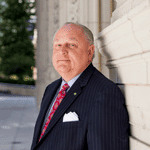
“I don’t care how we did it yesterday. If we did it for the first time today, how would we do it?”
Bob Six, Zeller Realty Group
Photo: Samantha Simmons
After 30 years in commercial real estate, Zeller Realty Group’s chief operating officer, Bob Six, came to his senses. If you had asked him about LEED certification in 2007, he would have had some choice words for you. “There’s an eight-letter word that I will use: ‘bullshit,’” Six says. “I would have said, ‘This doesn’t work from an economic standpoint, so let’s not waste our time.’”
But after gathering knowledge on green trends, Six developed a new view. As a 56-year-old father, he realized that he wanted to leave the world as a better place for his children, which led him to engage Paul Zeller, Zeller Realty’s CEO, in a discussion about changing the company’s sustainability practices. We sat down with Six and asked him about his journey.
gb&d: Your eventual reason for prioritizing sustainability had to do with your children, but how did this change come about?
Bob Six: After doing some reading and gathering more knowledge, I realized that sustainability was more than a trend—it was here to stay. I personally started to take a look at things differently. One of the mantras we try to use is: “I don’t care how we did it yesterday. If we did it for the first time today, how would we do it?”
gb&d: Was there any specific research you recall that led to this new viewpoint?
Six: The one that really changed my mind was a study by the University of San Diego’s Center of Business Real Estate and CBRE (the real estate services company), that found in LEED buildings employees were happier, productivity was greater, and the buildings were selling for 25 to 65 basis points less than your traditional office buildings, which translated to an increase in value of two to five percent.
gb&d: How did you convince the rest of the company?
Six: As an investor we have to be a little more diligent in our pursuit of creative value, and that’s why that particular model became so meaningful for us. We had a building with $14 million in net operating income. We estimated that it would cost us about $200,000 to get LEED Gold certification. The cap rate reduction in a sale scenario was the portion of the study that was most intriguing to us. We took a conservative approach and said, if we spend $200,000 and this building will sell for a minimum 25 basis points less, then this $14 million in NOI will have a value that is $4 million greater.
gb&d: What are the challenges of your specific market?
Six: Finding the opportunities that justify the risk. If you want to pursue a sustainable platform it doesn’t mean simply go and get certified. It is an ongoing process—you need to continue to monitor your operations over the LEED certification period to demonstrate to the USGBC that you’re committed to maintaining a sustainable environment and asset.
gb&d: Even with those challenges, what is most exciting to you in the industry?
Six: For me, these buildings are like the Lionel trains I treasured from my childhood because of the unique individuality of each train and the desire to collect them all. What young boy of my vintage growing up didn’t either have or dream of having a Lionel train set? For me, to be involved in this type of commerce as an adult is very exciting and gratifying because it allows me to continue collecting prized assets.
gb&d: What would you say is your firm’s standout project?
Six: The Wrigley Building is an iconic jewel of the Chicago skyline. We didn’t realize how challenging it was going to be to maintain some form of LEED certification because we were changing the majority of the systems for the better as well as replacing all of the windows with more energy-efficient windows. We were creating a 21st-century asset in the skin of a 20th-century gem. With having made the commitment to do these improvements, we also created an Achilles’ heel because the drop in occupancy during the extensive renovation would have caused The Wrigley Building to fall out of LEED certification compliance by renewal time. With our partner, GOBY, we were able to come up with a thoughtful and reasonable solution to maintain LEED certification through that time period.
gb&d: In a competitive industry, what sets Zeller Realty Group apart?
Six: There are a lot of things I could say that are probably obvious and hackneyed—things like our senior executive staff has been together for a minimum of 15 years, and the partnership and mutual respect has grown through that time period and has allowed us to work much closer together and almost seamlessly as a unit. [But what really sets us apart is] that ability to ostensibly see around corners, see opportunity where other people don’t see it. That’s what we describe as our “special sauce.” It’s based on our experience, our successes, yes, but it is also based on some of our failures. You can’t truly be successful if you don’t stub your toe every now and again.
gb&d: What upcoming projects are you excited about?
Six: Our plaza at 401 North Michigan Avenue is the largest privately owned plaza in the city. Watch it over the next three years and see what happens.

